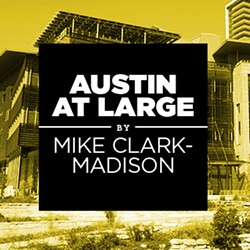Austin @ Large: A Bad Precedent
The courthouse deal: another chapter in the same old sad Downtown saga
By Mike Clark-Madison, Fri., Jan. 30, 2004

I'm not sure anything short of nuclear war can now derail the transformation of the Intel building into a new federal courthouse. (The site cleared mandated environmental review, allowing consummation of the purchase, earlier this month, and is now entering an 18-month design phase.) This deal was embraced as a win-Wynn so quickly, and by so many, that it seems pointless to conceive of a downside – Austin excises an unsightly (Smart) growth attached to Downtown's posterior, and the feds get a sexy site without having to use their awesome powers to steal somebody else's sexy site. So why am I not happier about this?
Well, first of all, look at Austin's two existing federal courts – the old Beaux Arts revival survival on West Eighth Street (next to the current City Hall) and the Homer Thornberry Judicial Building, joined to the Federal Building a few blocks east. The old courthouse is a generically nice building of its type and era – perhaps, once vacated, it would make a nice, uh, art museum. (Forget I said that. For a few minutes, at least.) But the cordon sanitaire thrown around it by the PATRIOT Act paranoia of our type and era has detonated a dirty bomb amid what was starting to become, and could be again, a mildly interesting slice of Downtown street life.
The Thornberry/Federal Building superblock – it grants the place undue dignity to call it a "complex" – is, of course, worse by several orders of magnitude. You know you've reached some sort of nadir of urban nondesign when your neighbors are soup kitchens and homeless shelters and they still make you look bad. (This was true even before the new, architecturally pleasing facilities to serve the homeless.) Even before 9/11, the plaza over Ninth Street, and the adjacent nonbuilding that was our Downtown post office once removed, with the entrance-less Thornberry Building attached to that, was on most Austin design heads' short list of places that deserved blowing up. Now that such a threat appears more serious and literal than before, the whole double block, behind barriers on every side, looks even more like the great urban spaces of the Warsaw Pact.
The U.S. General Services Administration, having been slapped around for decades for the atrocities born of federal construction, says it's cleaned up its act; it now hires real prestige architects – in Austin's case the Atlanta firm of Mack Scogin Merrill Elam (two people, husband and wife). But as the above bitchery suggests, whether the design of the new courthouse is good or poor, the policy that now governs federal projects will render it inert: mandatory 50-foot setbacks, ringed by bollards to keep future Timothy McVeighs from backing up the fertilizer truck. Is this really what we want facing Republic Square?
The Shadow Looms
Actually, while I'm in a heretical mood, I should confess that I've never really appreciated the boundless promise of Republic Square. I get that its proximity to the big booming blocks of the Warehouse District has conjured visions of great urban spaces – New York's Bryant Park is often cited – to dance before boosters' eyes. But such spaces emerge in cities when they're enclosed by – not "near," but actually next to – buildings where people make a special effort to be. (Like, in Bryant Park's case, the New York Public Library, one of the city's most beloved destinations.)
We've already blown half of Republic Square's potential; nobody wants to be near the state's Hobby Building, and they want even less to be near the hideous downtown post office of today. Scogin and Elam will have to work miracles to create a federal courthouse that triumphs over not only its own built-in design demerits but also those of its neighbors. That just leaves the south side of the square, the future home to the, uh, art museum.
You can remember what I said about the old courthouse now. I think that as soon as UT's Blanton Museum opens and Austin realizes it already has a first-class art museum, the AMOA saga will take a very quick and dramatic turn away from Republic Square. Perhaps this should be encouraged, perhaps not. But it's worth remembering that, before it was bought by Intel, the collection of old car lots assembled by developer Scott Young was dubbed "Museum Park" and envisioned as a mod, mixed-use, pedestrian-oriented environment of which AMOA and Republic Square were the focal point. Had that vision endured, spending a bunch of money to tart up the square, let alone to build the museum, would have been a worthy civic goal. Intel itself didn't kill off that vision, either when it moved in or even when it moved out. But a federal courthouse on the Intel site will do the job nicely, thank you very much.
Sounds Like a Plan – Not
In an effort to improve, or redeem, the courthouse and its effect on Republic Square, the city is now talking about closing and vacating the adjacent block of San Antonio Street, and/or making that street two-lane and two-way through the Warehouse District. Perhaps the Levyistas who so recently proclaimed that two-way and two-lane Downtown streets would destroy Austin as we know it will make an exception in this case. Anything to make the deal work! We gotta get rid of the Intel building!
Again, I ask heretically: Why? That is, why couldn't we have waited for an owner willing to put the rather minimal, as these things go, effort and expense into converting the Intel shell into a perfectly serviceable seven-story building whose uses were compatible with the visions and dreams that the Smart Growth era spawned for the Warehouse District? Intel was, famously and perhaps tragically, in no hurry to dump its Austin property.
Even the recovery-über-alles refrain rings sour here: The courthouse will take the land off the tax rolls, is moving in jobs that already exist only a few blocks away, and made quite clear it wasn't interested in a location outside Downtown. (This is a different issue for a different day, I suppose, but I'm not sure why the various redevelopment areas on the Eastside – the Bennett tract, the Saltillo District, even the Featherlite tract – couldn't have better accommodated a federal courthouse.)
But as I said at the top, this deal appears to be done to a turn. Which perhaps does point to a warning for Austin's future: The courthouse saga is a deal, not a vision or a plan, executed in the interests of expediency, just like the deals of the past that brought City Hall to the Warehouse District and then Computer Sciences Corporation to City Hall. With so many balls still in the air in Downtown's southwest quadrant – from MetLife and Block 21 and the AMOA all the way west to Seaholm and Lumbermen's and the Tips Iron Works – wouldn't it be nice if Austin finally embraced the oft-discussed ideas of a coordinated Downtown renewal strategy and the mechanisms to implement it? There's hope and optimism for you. But the courthouse deal does not set a good precedent. ![]()
Got something to say? The Chronicle welcomes opinion pieces on any topic from the community. Submit yours now at austinchronicle.com/opinion.








